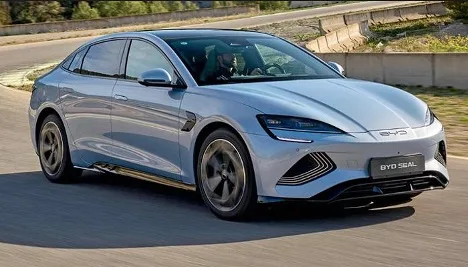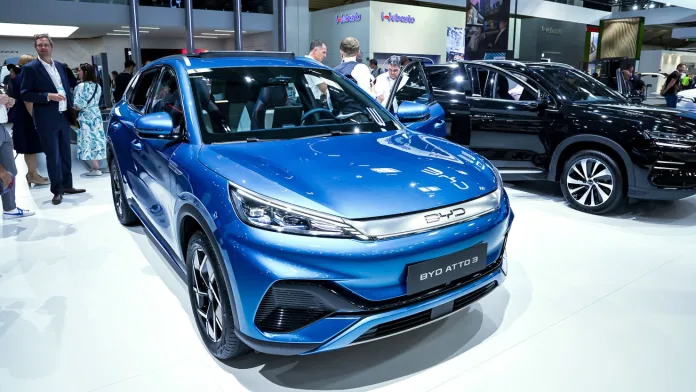Chinese automotive giant BYD is setting its sights on conquering international markets with an ambitious plan to double its overseas electric vehicle sales to 800,000 units by 2025. This bold strategy comes as the company reported impressive financial results, with annual revenue jumping 29% to reach 777 billion yuan ($107 billion) in 2024.
Table of Contents
BYD Electric Vehicles Set to Dominate Global Markets

BYD’s international push represents one of the most aggressive expansion plans in the electric vehicle industry. After selling 417,204 units outside China in 2024, the company is now targeting markets across Europe, Southeast Asia, and Latin America with a clear strategy to overcome trade barriers and establish a global footprint.
“We’re witnessing the beginning of a new chapter in the global automotive industry,” says Maria Chen, automotive industry analyst at EV Market Research. “BYD isn’t just expanding—they’re fundamentally reshaping how we think about international competition in the electric vehicle space.”
Strategic Factory Placement to Bypass Tariffs
One of the most fascinating aspects of BYD’s overseas expansion strategy is their approach to navigating potential tariffs. Rather than simply exporting vehicles from China, the company is establishing assembly plants in key markets:
- Brazil: Construction of a manufacturing facility already underway
- Thailand: Local assembly operations being established
- Hungary: New factory planned to serve European markets
- Turkey: Production facility in development
This local assembly approach allows BYD to maintain competitive pricing while creating jobs in target markets—a shrewd move that addresses both economic and political concerns.
“By assembling vehicles locally using components from China, BYD can maintain its cost advantage even in markets with high import tariffs,” explains Thomas Müller, international trade expert at Global Market Strategies. “It’s a textbook example of how to expand globally in today’s complex trade environment.”
BYD vs Tesla: The Battle for EV Supremacy Intensifies
As BYD accelerates its international growth, comparisons with Tesla are inevitable. While Tesla remains the dominant player in many Western markets, BYD’s numbers tell an impressive story:
| Metric | BYD (2024) | Tesla (2024) |
|---|---|---|
| Annual Revenue | $107 billion | $97.7 billion |
| Vehicle Deliveries | 4.27 million* | 1.79 million |
| Revenue Growth (YoY) | 29% | 18% |
*Includes both fully electric and hybrid vehicles
“The BYD vs Tesla rivalry is becoming one of the most watched competitions in the business world,” says James Wilson, editor of Electric Vehicle Monthly. “While Tesla has the brand recognition in Western markets, BYD has the manufacturing scale and price advantage that could ultimately prove decisive.”
Key Markets Driving Growth

BYD’s expansion isn’t a scattershot approach. The company has identified specific regions where it believes it can gain significant market share:
- United Kingdom: BYD sees Britain as particularly receptive to Chinese EVs, citing the market’s openness to competitive products regardless of origin.
- Latin America: With Brazil as the centerpiece, BYD is making a major push into Latin American markets where EV adoption is still in early stages.
- Southeast Asia: Leveraging geographic proximity and cultural ties, BYD is rapidly expanding its presence across Southeast Asian nations.
- Europe: Despite regulatory challenges, BYD is committed to European expansion through local production facilities in Hungary and Turkey.
“What’s remarkable about BYD’s approach is how tailored it is to each region,” notes Elena Kowalski, international business strategist. “They’re not simply exporting a Chinese product—they’re adapting their strategy to address the unique needs and challenges of each market.”
Challenges on the Horizon
Despite its ambitious plans, BYD faces significant hurdles in its global expansion:
- Geopolitical tensions have put plans for U.S. and Canadian market entry on hold
- Brand recognition remains limited in many Western markets
- Regulatory environments vary significantly across regions
- Established competitors are accelerating their own EV strategies
“The global EV market is becoming increasingly competitive,” warns Michael Zhang, automotive industry consultant. “BYD’s success will depend not just on their product quality and pricing, but on their ability to navigate complex regulatory and cultural landscapes in each target market.”
What This Means for the Electric Vehicle Market Growth

BYD’s aggressive expansion has significant implications for the broader industry:
- Accelerated price competition in key markets
- Pressure on established automakers to speed up EV transitions
- Potential for new manufacturing partnerships and technology sharing
- Faster development of charging infrastructure to support growing EV fleets
“We’re likely to see electric vehicle market growth accelerate even faster than current projections suggest,” predicts Sarah Johnson, sustainability researcher at Green Transport Initiative. “When a manufacturer with BYD’s scale and cost structure enters new markets, it creates a ripple effect throughout the industry.”
The Road Ahead: BYD’s Vision for 2025 and Beyond
As BYD continues its global march, the company is not just expanding its geographic footprint but also diversifying its product lineup. With everything from compact city cars to luxury SUVs and commercial vehicles, BYD is positioning itself as a full-spectrum provider of electric mobility solutions.
“What we’re witnessing is not just the growth of a company, but potentially a reshaping of the global automotive hierarchy,” concludes Dr. Robert Chen, professor of international business at Global Business School. “The EV market trends suggest we’re at an inflection point, and BYD’s overseas expansion could be one of the defining business stories of this decade.”
For consumers around the world, BYD’s expansion promises greater choice, more competitive pricing, and potentially faster adoption of electric vehicles—a win not just for the company, but for global sustainability efforts as well.


